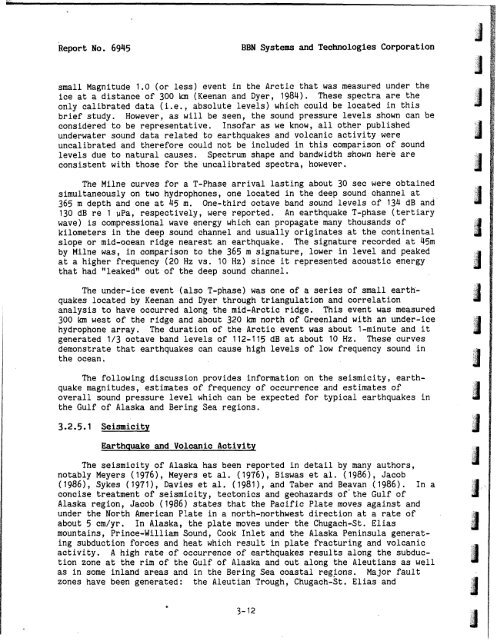Analysis and Ranking of the Acoustic Disturbance Potential of ...
Analysis and Ranking of the Acoustic Disturbance Potential of ...
Analysis and Ranking of the Acoustic Disturbance Potential of ...
Create successful ePaper yourself
Turn your PDF publications into a flip-book with our unique Google optimized e-Paper software.
Report No. 6945<br />
BBN Systems <strong>and</strong> Technologies Corporation<br />
small Magnitude 1.0 (or less) event in <strong>the</strong> Arctic that was measured under <strong>the</strong><br />
ice at a distance <strong>of</strong> 300 La (Keenan <strong>and</strong> Dyer, 1984). These spectra are <strong>the</strong><br />
only calibrated data (i.e., absolute levels) which could be located in this<br />
brief study. However, as will be seen, <strong>the</strong> sound pressure levels shown can be<br />
considered to be representative. Ins<strong>of</strong>ar as we know, all o<strong>the</strong>r published<br />
underwater sound data related to earthquakes <strong>and</strong> volcanic activity were<br />
uncalibrated <strong>and</strong> <strong>the</strong>refore could not be included in this comparison <strong>of</strong> sound<br />
levels due to natural causes. Spectrum shape <strong>and</strong> b<strong>and</strong>width shown here are<br />
consistent with those for <strong>the</strong> uncalibrated spectra, however.<br />
The Milne curves for a T-Phase arrival lasting about 30 sec were obtained<br />
simultaneously on two hydrophones, one located in <strong>the</strong> deep sound channel at<br />
365 m depth <strong>and</strong> one at 45 m. One-third octave b<strong>and</strong> sound levels <strong>of</strong> 134 dB <strong>and</strong><br />
130 dB re 1 uPa, respectively, were reported. An earthquake T-phase (tertiary<br />
wave) is compressional wave energy which can propagate many thous<strong>and</strong>s <strong>of</strong><br />
kilometers in <strong>the</strong> deep sound channel <strong>and</strong> usually originates at <strong>the</strong> continental<br />
slope or mid-ocean ridge nearest an earthquake. The signature recorded at 45m<br />
by Milne was, in comparison to <strong>the</strong> 365 m signature, lower in level <strong>and</strong> peaked<br />
at a higher frequency (20 Hz vs. 10 Hz) since it represented acoustic energy<br />
that had "leaked" out <strong>of</strong> <strong>the</strong> deep sound channel.<br />
The under-ice event (also T-phase) was one <strong>of</strong> a series <strong>of</strong> small earttiquakes<br />
located by Keenan <strong>and</strong> Dyer through triangulation <strong>and</strong> correlation<br />
analysis to have occurred along <strong>the</strong> mid-Arctic ridge. This event was measured<br />
300 km west <strong>of</strong> <strong>the</strong> ridge <strong>and</strong> about 320 km north <strong>of</strong> Greenl<strong>and</strong> with an under-ice<br />
hydrophone array. The duration <strong>of</strong> <strong>the</strong> Arctic event was about 1-minute <strong>and</strong> it<br />
generated 1/3 octave b<strong>and</strong> levels <strong>of</strong> 112-115 dB at about 10 Hz. These curves<br />
demonstrate that earthquakes can cause high levels <strong>of</strong> low frequency sound in<br />
<strong>the</strong> ocean.<br />
The following discussion provides information on <strong>the</strong> seismicity, earthquake<br />
magnitudes, estimates <strong>of</strong> frequency <strong>of</strong> occurrence <strong>and</strong> estimates <strong>of</strong><br />
overall sound pressure level which can be expected for typical earthquakes in<br />
<strong>the</strong> Gulf <strong>of</strong> Alaska <strong>and</strong> Bering Sea regions.<br />
3.2.5.1 Seismicity<br />
Earthquake <strong>and</strong> Volcanic Activity<br />
The seismicity <strong>of</strong> Alaska has been reported in detail by many authors,<br />
notably Meyers ( 1976), Meyers et al. (1976), Biswas et al. ( 1986), Jacob<br />
(1986), Sykes (1971), Davies et al. (1981), <strong>and</strong> Taber <strong>and</strong> Beavan (1986). In a<br />
concise treatment <strong>of</strong> seismicity, tectonics <strong>and</strong> geohazards <strong>of</strong>'<strong>the</strong> Gulf <strong>of</strong><br />
Alaska region, Jacob ( 1986) states that <strong>the</strong> Pacific Plate moves against <strong>and</strong><br />
under <strong>the</strong> North American Plate in a north-northwest direction at a rate <strong>of</strong><br />
about 5 cm/yr. In Alaska, <strong>the</strong> plate moves under <strong>the</strong> Chugach-St. Elias<br />
mountains, Prince-William Sound, Cook Inlet <strong>and</strong> <strong>the</strong> Alaska Peninsula generating<br />
subduction forces <strong>and</strong> heat which result in plate fracturing <strong>and</strong> volcanic<br />
activity. A high rate <strong>of</strong> occurrence <strong>of</strong> earthquakes results along <strong>the</strong> subduction<br />
zone at <strong>the</strong> rim <strong>of</strong> <strong>the</strong> Gulf <strong>of</strong> Alaska <strong>and</strong> out along <strong>the</strong> Aleutians as well<br />
as in some inl<strong>and</strong> areas <strong>and</strong> in <strong>the</strong> Bering Sea coastal regions. Major fault<br />
zones have been generated: <strong>the</strong> Aleutian Trough, ~hugach-st. Elias <strong>and</strong>
















